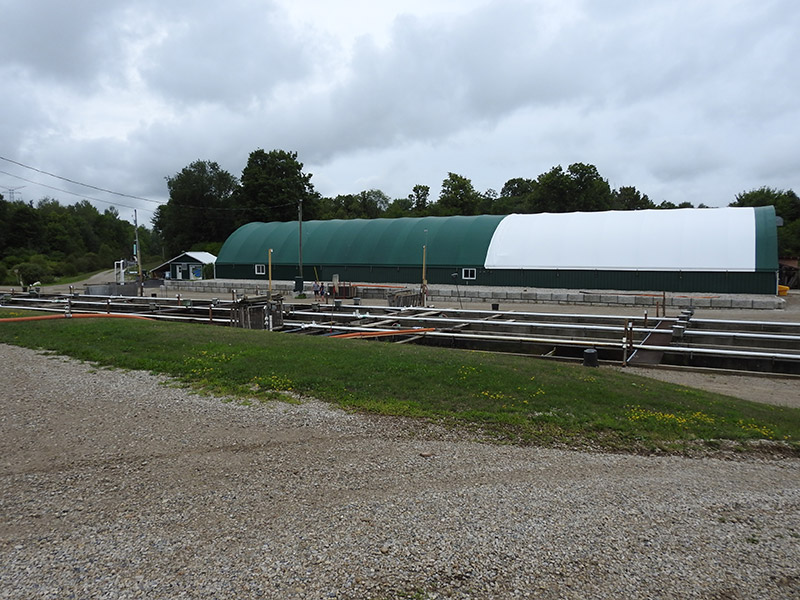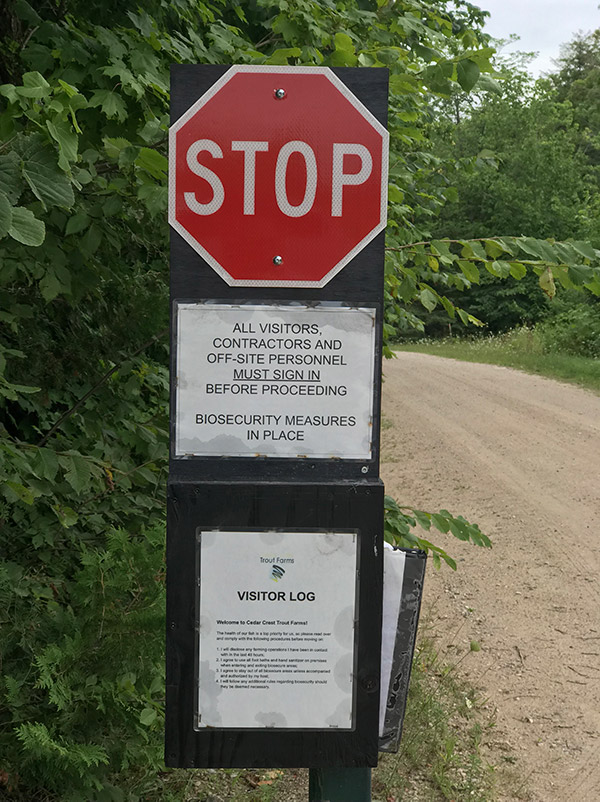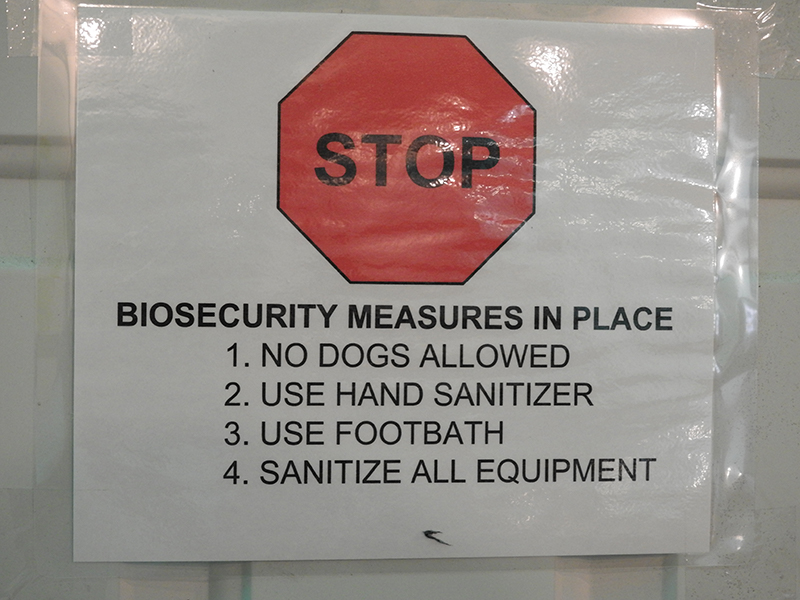Section 1 | Biosecurity in Aquaculture
Industry
Page 05 /
Biosecurity and Disease Prevention in Action: Cedar Crest Farms

Source: ACER Consulting Ltd.
Cedar Crest Trout Farms in Hanover, Ontario have devoted years of time and effort to ensure their fish are healthy and free of disease. Recently, the farm has attained Best Aquaculture Practices (BAP) certification. BAP certification is validation that a fish farm has undergone stringent, third party inspections ensuring that they are following the best of fish-rearing practices. These practices ensure fish health, food safety, environmental sustainability, and overall farm productivity.
RJ and Arlen Taylor, Cedar Crest’s co-owners, devoted around 4 years of effort to ensure practices and protocols met stringent BAP requirements. The following section tours you through their facility, highlighting some important practices and management techniques they employ to ensure high fish health and promote biosecurity.
The ultimate goal of biosecurity is to prevent infectious disease from entering and spreading on the farm. Biosecurity is focused on maintaining and improving animal health — healthy animals are more productive and need less antimicrobial medications and treatments.
RJ and Arlen have made biosecurity a priority for their farm.
Check Out Our Podcast
We sat down with the Taylor’s to discuss their approach to fish health management. Our conversations revolved around their perspectives on antimicrobial use in aquaculture, the practice of antimicrobial stewardship, and best practices for managing fish health
Farm Entry
Prior to entering the farm, all visitors are greeted with a sign that includes instructions on signing in and who to contact prior to entering the farm. All visitors must report their identity, the reason for visiting, and the duration of stay on the farm. Having a handle of the “who, what, when, where, and why” of farm visitors means that, if a disease outbreak ever happens on the farm, you’ll be able to better evaluate how it may have entered. As well, you can periodically assess the relative risk that certain visitors pose to your operation and potentially limit their access.

Source: ACER Consulting Ltd.
Movement on the Farm
Cedar Crest are constantly aware of how animal, equipment, and human movement into and within their farm can impact animal health. With respect to VHS as previously discussed, Cedar Crest falls in the yellow zone — Arlen and RJ are very conscious about the source and flow of their fish. Fish from red zones in Ontario do not enter any of their facilities. Also, they devote a lot of time and effort to testing a random sample of their fish on an annual basis to ensure they are free of the disease.
In addition to the VHS management zones and restricted and monitored farm access, Cedar Crest have several practices that reduce disease transmission to the farm.
Cedar Crest spans several farm sites. Management focuses on keeping equipment at the home farm. Whenever it is necessary to transfer equipment from one site to another, it is disinfected thoroughly both before it leaves and before it returns to the home farm.

Source: ACER Consulting Ltd.

Source: ACER Consulting Ltd.
There is restricted access to areas of the farm with instructions on how to enter each section posted on the door. There are footbaths at door entry – these baths are filled with antiseptic solution and are changed daily to ensure footwear is adequately disinfected.

Source: ACER Consulting Ltd.
Farm personnel and visitors can play a role in spreading disease on the farm!
Cedar Crest clearly stipulate biosecurity requirements for everyone moving within the farm.
People, animals, and equipment can be contaminated with bacteria, viruses, fungi, and parasites in the normal course of a day. Without systematic disinfection, these bugs can be spread throughout the farm.
Think about this example. Let’s say you are treating a tank of older fish for columnaris disease. In the course of your treatment, you handle several dead fish that were infected with the disease. Your hands likely now have become contaminated with the bacteria. Without proper disinfection, if you were to walk over to the growing fry tanks, your hands could contaminate the environment and equipment present in this housing area.
The Toronto General Hospital produced an entertaining video that illustrates how easily infectious disease can be transmitted if you don’t take the appropriate biosecurity precautions: Wash your hands, it just makes sense. You can see how a lapse in cleanliness can lead to the spread of potentially harmful bugs on the farm!
It is also important to consider the sequence of your movements on the farm. The goal should be to minimize the infectious challenge of the most susceptible animals. For instance, it is not a good idea to clean manure from tanks of older fish, then go directly to feeding young fry. A more logical sequence would be to start chores with the youngstock (who are most susceptible to disease), then move on to tasks involving more resistant (typically older) animals.